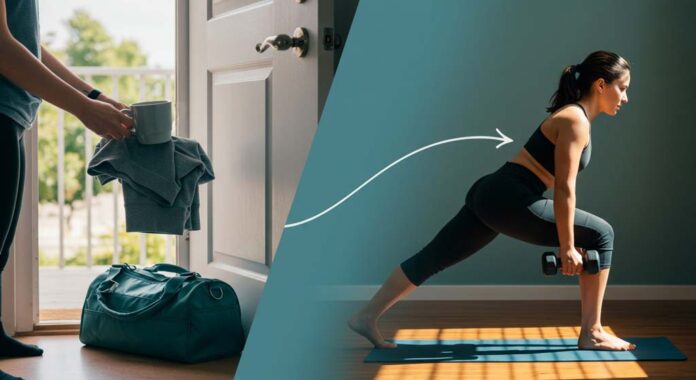Learning to make exercise a daily habit shifts it from a challenging task into a natural part of your day. Regular exercisers report better health outcomes, with studies showing they take fewer sick days yearly than non-exercisers.
Building fitness consistency over time creates lasting positive changes in your body and mind. Your body responds well to regular movement but reacts quickly when exercise stops – strength can decline by 3% weekly.
Habits shape our daily actions more than willpower alone. They become our automatic responses, especially during busy or stressful periods. When you make exercise a daily habit, it becomes as natural as brushing your teeth.
The science of habit formation reveals fascinating insights about exercise consistency. From creating powerful daily triggers to overcoming common barriers, small changes lead to lasting results. Your journey towards effortless exercise starts here.
Building Exercise Habit Pathway
Preparation Habits
- Setting out exercise clothes
- Planning workout time
- Preparing gym bag
- Setting morning alarm
Exercise Triggers
- Visual cues
- Time-based reminders
- Environmental setup
- Mental readiness
Consistent Exercise Performance
- Regular workout completion
- Reduced decision fatigue
- Automatic behavior
- Long-term adherence
Make Exercise a Daily Habit for Better Health
Your brain responds powerfully to repeated behaviours. Your brain strengthens these pathways when actions bring rewards, creating automatic responses to specific situations.
The process starts with small, manageable changes. Studies reveal that preparation habits are more significant in exercise success than actual workout habits. Setting your gym clothes or planning your workout time creates strong mental cues that trigger action.
To make exercise a daily habit, focus on building these preparation routines first. Your brain forms stronger connections when you link exercise to existing daily patterns. Morning coffee becomes a signal for your walk or finishing work cues your gym session.
Successful habit formation relies on internal rewards. The satisfaction of completing a workout or feeling more energised reinforces your exercise patterns. When you make exercise a daily habit, these positive feelings strengthen your commitment.
Simple Strategies That Make Exercise Stick
Creating lasting exercise habits requires more than motivation alone. Evidence shows that combining multiple support strategies helps you make exercise a daily habit.
Setting up your environment plays a vital role in maintaining exercise patterns. Research highlights that having proper gear, safe workout spaces, and convenient timing increases consistency. Small changes in your surroundings can remove common barriers to exercise.
Personal monitoring strengthens your exercise routine:
- Use logbooks or fitness apps to track your sessions
- Set regular reminders through emails or messages
- Monitor your progress with simple fitness tests
- Keep notes about what works best for you
Building support systems enhance your success:
- Find workout partners for accountability
- Share your progress with friends or family
- Join exercise groups with similar goals
- Connect with others who share your fitness interests
Professional guidance at the start helps make exercise a daily habit. Working with experienced fitness guides, especially when beginning, improves safety and adherence. They help create exercise plans that match your current fitness level.
| Component | Beginners | Intermediate | Advanced |
|---|---|---|---|
| Frequency | 2-3 days per week | 3-4 days per week | ≥5 days per week |
| Intensity | Light to moderate (40-59% HRR) | Moderate (50-69% HRR) | Moderate to vigorous (60-89% HRR) |
| Time | 10-20 minutes per session | 20-40 minutes per session | 30-60 minutes per session |
| Progression | Increase by 5-10 mins every 1-2 weeks | Increase intensity or duration monthly | Vary workouts to maintain challenge |
How to Make Exercise a Daily Habit That Lasts
Starting gradually builds a strong foundation for lasting habits. Your body adapts better to gentle progression, with studies showing that beginning at light intensity helps prevent early setbacks.
To make exercise a daily habit, focus on smart progression. In the first month, increase your exercise by 5-10 minutes weekly. This steady approach allows your body and mind to adjust naturally.
Exercise timing matters for habit formation. Research shows that habits form more easily when linked to specific daily events. Whether morning, afternoon, or evening, consistency in timing helps make exercise a daily habit.
Regular monitoring helps you stay on track without becoming obsessed with numbers. Simple checks, such as noting your energy levels or tracking basic progress markers, provide valuable feedback.

Dealing with Setbacks Without Giving Up
Setbacks naturally occur on any fitness journey. Research shows that anticipating potential obstacles strengthens your ability to overcome them.
Challenges like travel, illness, or busy periods often disrupt exercise patterns. To make exercise a daily habit, plan ahead for these situations. Having backup options ready helps maintain momentum during challenging times.
Preparation habits prove especially valuable during disruptions:
- Keep essential exercise equipment readily available
- Plan alternative activities for different situations
- Identify backup times for your usual exercise slot
- Create modified versions of your regular routine
Building resilience means viewing interruptions as temporary pauses, not permanent stops. When you make exercise a daily habit, small breaks don’t erase your progress or diminish your capabilities.
Research highlights that consistent exercisers face the same challenges as everyone else. The difference lies in their response – they expect and plan for obstacles rather than hoping to avoid them.
Exercise habits integrate into life’s natural ebbs and flows. Each person’s path weaves uniquely through daily commitments, energy levels, and changing circumstances. Science reveals that sustainable habits flex and adapt, growing stronger through challenges rather than breaking under pressure.
Sources
- American College of Sports Medicine. ACSM’s Guidelines for Exercise Testing and Prescription. 10th ed. Philadelphia (PA): Wolters Kluwer; 2018. 480 p.
- Bailey DL, Holden MA, Foster NE, Quicke JG, Haywood KL, Bishop A. Defining adherence to therapeutic exercise for musculoskeletal pain: a systematic review. Br J Sports Med. 2020;54(6):326–331.
- Blimkie CJ, Ramsay MJ, Ramsey J, et al. The effects of detraining and maintenance weight training on strength development in prepubertal boys. Can J Sport Sci. 1989;14:104.
- Czajkowski, S. M., Powell, L. H., Adler, N., Naar‐King, S., Reynolds, K. D., Hunter, C. M., Laraia, B., Olster, D. H., Perna, F. M., Peterson, J. C., Epel, E., Boyington, J. E., & Charlson, M. E. (2015). From ideas to efficacy: The ORBIT model for developing behavioral treatments for chronic diseases. Health Psychology, 34(10), 971–982.
- Donnelly JE, Blair SN, Jakicic JM, Manore MM, Rankin JW, Smith BK., American College of Sports Medicine. American College of Sports Medicine Position Stand. Appropriate physical activity intervention strategies for weight loss and prevention of weight regain for adults. Med Sci Sports Exerc. 2009 Feb;41(2):459-71.
- Duthie GM. A framework for the physical development of elite rugby union players. Int J Sports Physiol Perform. 2006;1(1):2–13.
- Garber CE, Blissmer B, Deschenes MR, et al. American College of Sports Medicine position stand. The quantity and quality of exercise for developing and maintaining cardiorespiratory, musculoskeletal, and neuromotor fitness in apparently healthy adults: guidance for prescribing exercise. Med Sci Sports Exerc. 2011;43(7):1334–59.
- Gardner, B. (2015). A review and analysis of the use of ‘habit’ in understanding, predicting and influencing health‐related behaviour. Health Psychology Review, 9, 277–
- Hagger MS, Luszczynska A. Implementation intention and action planning interventions in health contexts: state of the research and proposals for the way forward. Appl Psychol Health Well Being. 2014 Mar;6(1):1-47.
- Hoffman MD, Krishnan E. Health and exercise-related medical issues among 1,212 ultramarathon runners: baseline findings from the Ultrarunners Longitudinal TRAcking (ULTRA) study. PLoS One (2014) 9(1):e83867.
- Hughes SL, Seymour RB, Campbell RT, Desai P, Huber G, Chang HJ. Fit and strong!: bolstering maintenance of physical activity among older adults with lower-extremity osteoarthritis. Am J Health Behav. 2010;34(6):750–763.
- Jordan JL, Holden MA, Mason EE, Foster NE. Interventions to improve adherence to exercise for chronic musculoskeletal pain in adults. Cochrane Database Syst Rev. 2010;2010(1):CD005956.
- Kaushal, N., Rhodes, R. E., Meldrum, J. T., & Spence, J. C. (2017). The role of habit in different phases of exercise. British Journal of Health Psychology, 22(3), 429–448.
- Kelders SM, Kok RN, Ossebaard HC, van Gemert-Pijnen JEWC. Persuasive system design does matter: a systematic review of adherence to web-based interventions. J Med Internet Res. 2012;14(6):e152.
- Lally, P., & Gardner, B. (2013). Promoting habit formation. Health Psychology Review, 7, S137–S158.
- Larson, H. K., McFadden, K., McHugh, T. L. F., Berry, T. R., & Rodgers, W. M. (2017). You can’t always get what you want: Expectations, outcomes, and adherence of new exercisers. Qualitative Research in Sport, Exercise and Health, 9(3), 389–402.
- Michie S, van Stralen MM, West R. The behaviour change wheel: a new method for characterising and designing behaviour change interventions. Implement Sci. 2011;6:42.
- Michie S, Abraham C, Whittington C, McAteer J, Gupta S. Effective techniques in healthy eating and physical activity interventions: a meta-regression. Health Psychol. 2009;28(6):690-701.
- Phillips, L. A., & Mullan, B. A. (2022). Ramifications of behavioural complexity for habit conceptualisation, promotion, and measurement. Health Psychology Review, 17, 402–415.
- Phillips, L. A., & Gardner, B. (2016). Habitual exercise instigation (versus execution) predicts healthy adults’ exercise frequency. Health Psychology, 35(1), 69–77.
- Riebe D, Franklin BA, Thompson PD, et al. Updating ACSM’s recommendations for exercise preparticipation health screening. Med Sci Sports Exerc. 2015;47(8):2473–9.
- Schwarzer, R. (2016). Health action process approach (HAPA) as a theoretical framework to understand behavior change. Actualidades en Psicología, 30(121), 119–130.
- Stetson BA, Beacham AO, Frommelt SJ, et al. Exercise slips in high-risk situations and activity patterns in long-term exercisers: an application of the relapse prevention model. Ann Behav Med. 2005;30(1):25-35.
- Strack F, Deutsch R. (2004). Reflective and impulsive determinants of social behavior. Personality and Social Psychology Review, 8(3):220–247.
- Warburton DE, Bredin SS, Charlesworth SA, Foulds HJ, McKenzie DC, Shephard RJ. Evidence-based risk recommendations for best practices in the training of qualified exercise professionals working with clinical populations. Appl Physiol Nutr Metab. 2011;36(1 Suppl):S232–65.
- Woolley, K., & Fishbach, A. (2015). The experience matters more than you think: People value intrinsic incentives more inside than outside an activity. Journal of Personality and Social Psychology, 109(6), 968–982.



